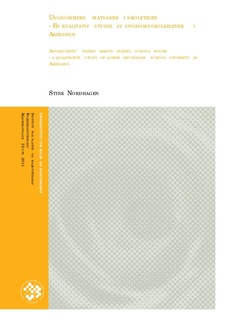| dc.description.abstract | Sammendrag
Bakgrunn: Ungdomstiden er viktig i et folkehelseperspektiv, ettersom det er i disse årene man legger grunnlaget for helse og helsevaner senere i livet. Man har sett at ungdommers kosthold blant annet inneholder for mye mettet fett og sukker. Ungdom tilbringer mye tid på skolen, og dette gjør at skolen blir en naturlig arena for forebyggende arbeid blant unge.
Hensikt: Hensikten med denne undersøkelsen er å få økt forståelse for hvilke faktorer som har innvirkning på ungdommers kosthold i skoletiden. Det er ungdommenes egne tanker og opplevelser som står i fokus. Øvrige delmål er å få mer kunnskap om hva de samme ungdommene vanligvis spiser på skolen, hvor de får maten sin fra, samt hvilke tanker de har rundt skolens kantine og Skolefruktordningen.
Metode: Det ble gjennomført to semi-strukturerte fokusgruppeintervjuer med ungdomsskoleelever fra to skoler i Akershus. Intervjupersonene ble rekruttert via skolene, og utvalget bestod av til sammen ni ungdommer, tre jenter og seks gutter i alderen 14-15 år.
Resultater: Om lag halvparten av deltakerne hadde med seg matpakke på skolen som foreldrene eller de selv hadde smurt, og resten av deltakerne kjøpte mat i kantinen eller butikken i nærheten av skolen. Ungdommene hadde ulike meninger om hvilke faktorer som hadde innvirkning på kostholdet deres. Flere mente at foreldre, venner og kantinens utvalg hadde innvirkning. Det kom også fram at matens smak, pris og hvor sunn den var, var noe som hadde innvirkning på valgene de tok. Deltakerne hadde mange innspill på skolenes kantiner og Skolefruktordningen. Noen mente for eksempel at kantinene burde selge grovere brød og mer grønnsaker. Flere av deltakerne mente at frukten i Skolefruktordningen ofte var overmoden og skadet, mens andre mente den var frisk og god.
Diskusjon: De to intervjuene ble tolket og diskutert felles, og knyttet opp mot aktuell teori. Det var særlig to nasjonale studier (Bjelland & Klepp 2000; Bugge 2007) som funnene i denne undersøkelsen ble sammenliknet med.
Konklusjon: Mange faktorer ble rapportert å ha innvirkning på ungdommenes kosthold. Ungdommene uttrykte at de er opptatt av hva de spiser, samt at foreldre, venner og hva som tilbys på de ulike utsalgsstedene har en innvirkning på hva de velger å spise på skolen. Ungdommene hadde også mange meninger om kantinens utvalg og Skolefruktordningen, blant annet mente de at kantinene burde selge sunnere mat og at frukten de får ikke alltid er fersk.
Abstract
Background: Adolescence is important in a public health perspective, as many people in this period lay the foundation for health and health habits later in life. Studies have shown that Norwegian adolescents, among other factors, consume too much saturated fat and sugar. Adolescents spend a lot of time at school, which makes the school a natural arena for preventive work among young people.
Objectives: The purpose of this study is to increase the comprehension about factors that influence adolescents’ dietary choices during school hours. The focus is on the adolescents’ thoughts and experiences. The remainder goals are to increase the knowledge about what the same adolescents usually eat at school, where they get the food from, and what thoughts they have about the canteen and school fruit program.
Methods: Two semi-structured focus groups were undertaken with lower secondary school students from two schools in Akershus. The interview subjects were recruited from the schools, and the sample consisted of a total of nine adolescents, three girls and six boys aged 14-15 years.
Results: About half of the participants usually brought a lunch packet to school, prepared by their parents or themselves. The rest of the participants usually bought their lunch in the canteen at school or in a store or kiosk nearby. The participants had different opinions about factors that influence their diet at school. They mentioned that parents, friends and the canteen selection had an impact. Other factors that influence their diet were taste, price and how healthy the food was. The participants had many views on the canteens and school fruit program. Some thought that the canteen should offer whole wheat bread and more vegetables. Some of the participants thought the fruit from the school program often was overripe and damaged, while others thought the fruit was fresh and tasty.
Discussion: The interviews were jointly interpreted and discussed, and compared with relevant theory. There were in particular two Norwegian studies (Bjelland & Klepp 2000; Bugge 2007) the findings in this study were compared with.
Conclusion: Many factors were reported to have an impact on the adolescents’ diets. The participants expressed that they care about what they eat, and that, among other factors, parents, friends and the food that is offered at the various outlets, have an impact on their diet at school. They also had a lot of opinions on the canteen selection and school fruit program. They mentioned, among other factors, that the canteens should offer a healthier selection of food, and that they sometimes received fruit that was not fresh. | no_NO |
